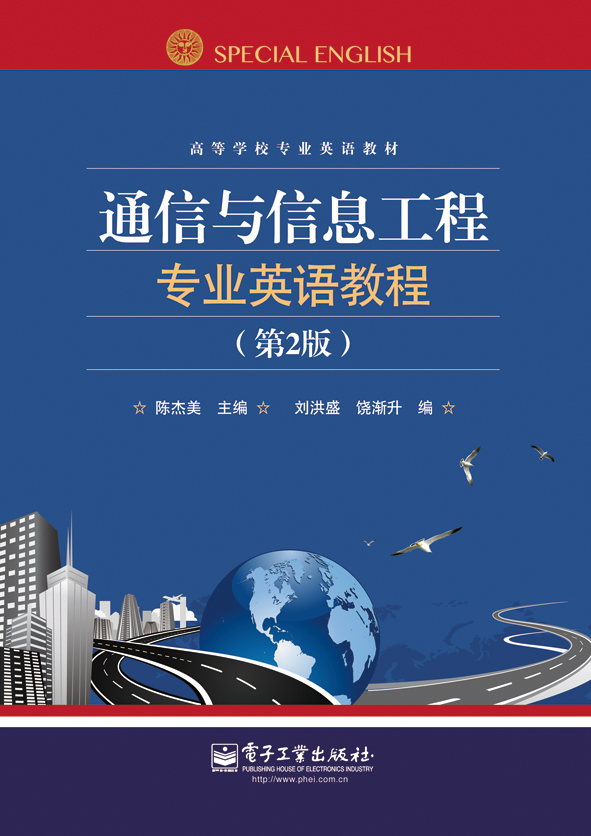圖書內容
本書旨在培養和提高學生在通信專業方面的
英語閱讀、筆譯能力,同時也有助於培養英語專業文章的寫作能力和對專業問題的口頭表達能力。
本書簡要介紹科技英語的基本知識和特點。本書課文精選自國外知名大學的通信工程教科書,涵蓋現代電子通信的各個領域,系統性強,且行文流暢。各課皆附有生詞表、難點注釋和練習題。書後附有參考譯文和參考文獻。
目錄
CONTENTS
Lesson 0 科技英語的基礎知識
0.1 科技英語中的幾個關鍵問題
(Some Key Problems in Scientific and Technical English)
0.1.1 辭彙(Vocabularies or Words)
0.1.2 虛義詞(Form Words)
0.1.3 長句(Long Sentences)
0.2 翻譯的準則(Criteria of Translation)
0.3 翻譯中的變換(Changes in Translation)
0.3.1 詞類的變換(Changes Between Word Classes)
0.3.2 詞序的變換(Changes in Word Order)
0.3.3 省略(Ellipsis)
0.3.4 補充(Supplements)
0.3.5 引申(Extensions)
0.4 關於數量(Numbers and Quantities)
0.4.1 數制(Number Systems)
0.4.2 量詞的縮寫(Abbreviations about Numbers)
0.4.3 關於數量的增減(About Increase and Decrease)
0.5 數學符號與數學式(Mathematic Symbols and Expressions)
0.5.1 常用數學符號(Mathematic Symbols)
0.5.2 常用希臘字母(Grecian Letters)
0.5.3 常用數學式(Mathematic Expressions)
0.6 論文標題與摘要的寫作(How to Write a Thesis)
0.6.1 論文標題(How to Write the Title)
0.6.2 論文摘要(How to Write the Abstract)
0.6.3 論文摘要的常用句型(Some Useful Patterns Used in the Abstract)
0.6.4 例子(Examples)
Lesson 1 Introduction to Electronic Communications
1.1 Historical Perspective
1.2 Electronic Communications Systems
1.3 The Electromagnetic Spectrum
1.4 Bandwidth and Information Capacity
Reading Material
Lesson 2 Information Sources
2.1 Speech and Music
2.2 Pictures
2.3 Computer Data
2.4 Noise
Reading Material
Lesson 3 Information Systems
3.1 Information and Data
3.2 Information System
3.3 Computerbased Information System
3.4 Business Information Systems
Reading Material
Lesson 4 Signal Generation
4.1 LC Circuits
4.2 Oscillators
4.3 IntegratedCircuit Waveform Generation
4.4 Digital Waveform Generation
Reading Material
Lesson 5 Random Processes
5.1 Introduction
5.2 Mathematical Definition of a Random Process
5.3 Stationary Process
5.4 Mean, Correlation, and Covariance Functions
5.5 Ergodic Processes
5.6 Gaussian Process
Reading Material
Lesson 6 Amplitude Modulation Transmission
6.1 Principles of Amplitude Modulation
6.2 Singleside Band Modulation
6.3 Generation of SSB Waves
6.4 Weaver SSB frequency shifting technique
Reading Material
Lesson 7 Angle Modulation
7.1 Representation of PM and FM Signals
7.2 Spectra of AngleModulated Signals
7.3 Narrowband Angle Modulation
7.4 Wideband Frequency Modulation
7.5 Preemphasis and Deemphasis in AngleModulated Systems
Reading Material
Lesson 8 Video Communications
8.1 Overview of Video communication
8.2 Typical Video applications
8.3 Communication Networks
Reading Material
Lesson 9 Transmission Lines
9.1 Types of Transmission Lines
9.2 Transmissionline Wave Propagation
9.3 Timedomain Reflectometry
Reading Material
Lesson 10 Electromagnetic Wave Propagation
10.1 Introduction
10.2 Optical Properties of Radio Waves
10.3 Terrestrial Propagation of Electromagnetic Waves
Reading Material
Lesson 11 Antennas and Waveguides
11.1 Introduction
11.2 Antenna Terminology and Definitions
11.3 Antenna Arrays and Array Antenna[14]
11.4 Waveguides
Reading Material
Lesson 12 Optical fiber communications
12.1 Fibers in communications
12.2 FiberOptic Communication Equipment
12.3 Transmitters Operational Considerations
12.4 WDM Systems
Reading Material
Lesson 13 Digital Modulation
13.1 Introduction
13.2 Factors That Influence the Choice of Digital Modulation
13.3 Binary Modulated Bandpass Signaling
13.4 Multilevel Modulated Bandpass Signaling
Reading Material
Lesson 14 Data Communications, Codes Error Control
14.1 Introduction
14.2 Data Communications Circuits
14.3 Data Communications Codes
14.4 Error Control
Reading Material
Lesson 15 Communication Networks
15.1 Telephone Networks
15.2 Computer Networks
15.3 Cable Television Networks
15.4 Wireless Networks
Reading Material
Lesson 16 Software Radio
16.1 Introduction
16.2 Characters of a Software Radio
16.3 The RF FrontEnd
16.4 Smart Antennas
16.5 Digital Generation of Signals
Reading Material
Lesson 17 Microwave Radio Communications
17.1 Introduction
17.2 FrequencyModulated Microwave Radio System
17.3 Digital Radio Systems
Reading Material
Lesson 18 Satellite Communication Systems
18.1 Introduction
18.2 Design of the Satellite Link
18.3 Network Architecture
18.4 Geostationary Satellite Systems
Reading Material
Lesson 19 Multiple Accessing
19.1 Introduction
19.2 Frequency Division Multiple Access
19.3 Time Division Multiple Access and ALOHA
19.4 Code Division Multiple Access
Reading Material
Lesson 20 Mobile Telephone Service
20.1 Introduction
20.2 Basic Cellular Telephone Concepts
20.3 Digital Cellular Telephone
20.4 Codedivision Multiple Accessing
Reading Material
參考譯文
參考文獻

